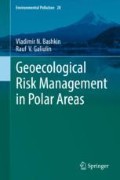Abstract
Biogeochemical technologies for recultivation of disturbed soils in impacted polar ecosystems are considered in this chapter. Techniques for monitoring the effectiveness of recultivation of disturbed tundra soils of different granulometric composition by analyzing enzyme activity, as well as the relevant technique for assessing the effectiveness of reclamation by peat in disturbed tundra soils with different full moisture capacity, are discussed. A technique for obtaining potassium humate from the local peat in the Yamal-Nenets Autonomous Okrug [District], Russia, is also presented. Finally, a technique for assessing the effectiveness of recultivation of disturbed tundra soils by application of local peat and potassium humate is demonstrated.
Access this chapter
Tax calculation will be finalised at checkout
Purchases are for personal use only
References
Alekseev, A. O., & Bashkin, V. N. (2017). NMR C13 measurements for assessing humates from tundra peats. In V. Bashkin (Ed.), Ecological and biogeochemical cycling in impacted polar ecosystems (Environmental remediations, technologies, regulations and safety series) (pp. 101–128). New York: Nova Science.
Arno, O. B., Arabsky, A. K., Bashkin, V. N., Galiulin, R. V., Galiulina, R. A., Maklyuk, O. V., & Priputina, I. V. (2013). Method of control of recultivation efficiency of the disturbed tundra soils of different granulometric composition by means of the analysis of dehydrogenase activity. Russian Union patent 2491137.
Arno, O. B., Arabsky, A. K., Bashkin, V. N., Galiulin, R. V., Alekseev, A. O., Galiulina, R. A., Maltseva, A. N., Yamnikov, S. A., Nikolaev, D. S., & Murzagulov, V. R. (2017a). Method of receiving of potassium humate from local peats of the Yamal-Nenets Autonomous Okrug. Russian Union patent 2610956.
Arno, O. B., Arabsky, A. K., Bashkin, V. N., Galiulin, R. V., Galiulina, R. A., Alekseev, A. O., Salbiev, T. Kh.-M., & Serebryakov, E. P. (2017b). Method of assessment of recultivation efficiency by means of peat of the disturbed tundra soils with different full moisture capacity. Russian Union patent 2611159.
Arno, O. B., Arabsky, A. K., Bashkin, V. N., Galiulin, R. V., Galiulina, R. A., Alekseev, A. O., Yamnikov, S. A., Nikolaev, D. S., & Murzagulov, V. R. (2017c). Method of assessment of recultivation efficiency of the disturbed tundra soils by means of introduction of local peat and potassium humate. Russian Union patent 2611165.
Bashkin, V. N., Bukhgalter, E. B., Galiulin, R. V., Kalinina, I. E., & Galiulin, R. A. (2010b). Control method for cleaning of soils contaminated by hydrocarbons and neutralization of hydrocarbon sludges by dehydrogenase activity analysis. Russian Union patent 2387996.
Dospekhov, B. A. (1985). Technique of field experiment (with bases of statistical processing of research results). Moscow: Agropromizdat. 351 pp.
Emelyanova, T. Y., & Kramarenko, V. V. (2004). Justification of a technique of studying of deformation properties of peat taking into account change of extent of its degradation. News of Tomsk Polytechnic University, 307(5), 54–57.
Kalabin, G. A., Kanitskaya, L. V., & Kushnarev, D. F. (2000). Quantitate spectroscopy of a nuclear-magnetic-resonance of natural of organic raw materials and products of its processing. Moscow: Khimiya. 407 pp.
Kaurichev, I. C., Panov, N. P., Stratonovich, M. V., Grechin, I. P., Savich, V. I., Ganzhara, N. F., & Mershin, A. P. (1980). Practicum on soil science. Moscow: Kolos. 272 pp.
Radojevic, M., & Bashkin, V. N. (2006). Practical environmental analysis (textbook), 2nd ed. Cambridge: Royal Chemical Society Publications, UK. 457 pp.
Sartakov, M. P. (2008). Spectroscopy of a nuclear-magnetic-resonance 13С of humic acids of peat of the Middle Pre-Ob River basin. Chemistry of Vegetable Raw Materials, 3, 135–139.
Author information
Authors and Affiliations
Rights and permissions
Copyright information
© 2019 Springer Nature Switzerland AG
About this chapter
Cite this chapter
Bashkin, V.N., Galiulin, R.V. (2019). Biogeochemical Technologies for Recultivation of Disturbed Soils in Impacted Polar Ecosystems. In: Geoecological Risk Management in Polar Areas. Environmental Pollution, vol 28. Springer, Cham. https://doi.org/10.1007/978-3-030-04441-1_7
Download citation
DOI: https://doi.org/10.1007/978-3-030-04441-1_7
Published:
Publisher Name: Springer, Cham
Print ISBN: 978-3-030-04440-4
Online ISBN: 978-3-030-04441-1
eBook Packages: Earth and Environmental ScienceEarth and Environmental Science (R0)

